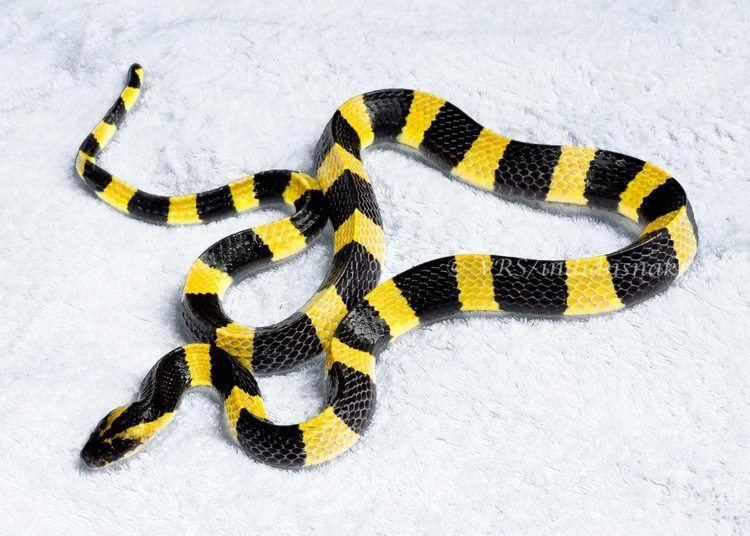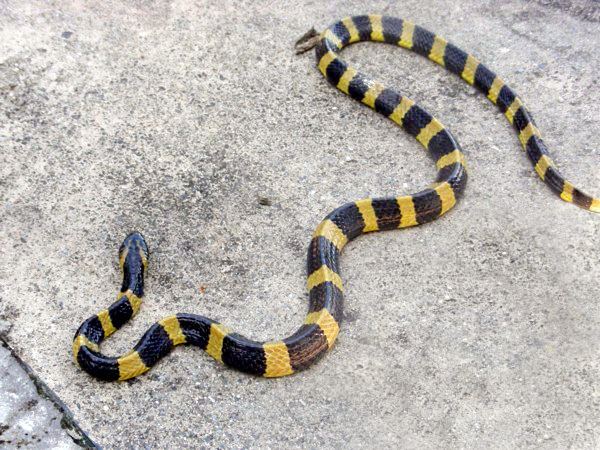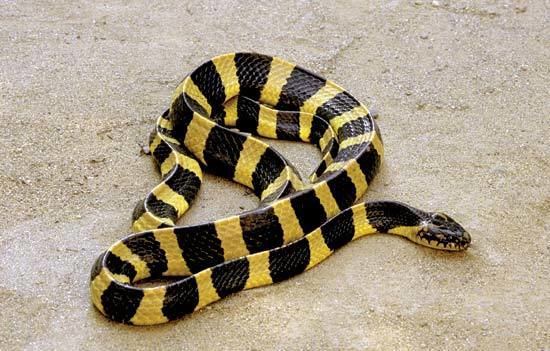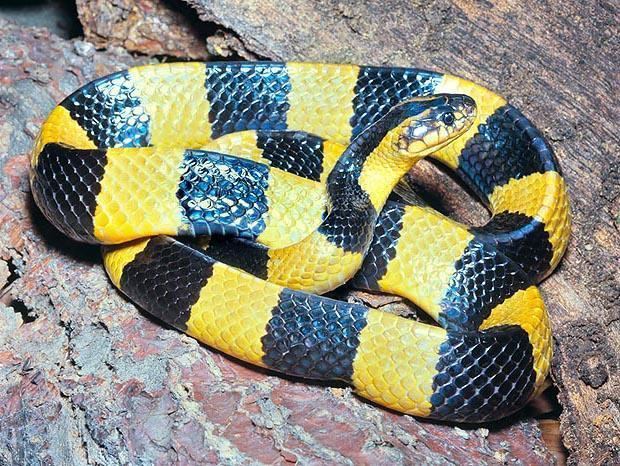Subphylum Vertebrata | ||
 | ||
Similar Indian kraits, Snake, Bungarus candidus, Common krait, King cobra | ||
Banded krait yellow black deadly snake thailand
The banded krait (Bungarus fasciatus) is a species of elapid snake found on the Indian Subcontinent and in Southeast Asia. It is one of the largest kraits, with a maximum length up to 2.1 m (6 ft 11 in).
Contents
- Banded krait yellow black deadly snake thailand
- Banded krait by akash dont try this at home without adequate training
- Description
- Distribution and habitat
- Behaviour
- Food
- Breeding habits
- Venom
- Common names
- References

Banded krait by akash dont try this at home without adequate training
Description

B. fasciatus is easily identified by its alternate black and yellow crossbands, its triangular body cross section, and the marked vertebral ridge consisting of enlarged vertebral shields along its body. The head is broad and depressed. The eyes are black. It has arrowhead-like yellow markings on its otherwise black head and has yellow lips, lores, chin, and throat.

The longest banded krait measured was 2.25 m (7 ft 5 in) long, but normally the length encountered is 1.8 m (5 ft 11 in).

The snake has an entire anal plate and single subcaudals. The tail is small and ends like a fingertip, generally being one-tenth the length of the snake.
Distribution and habitat

The banded krait occurs in the whole of the Indo-Chinese subregion, the Malaysian peninsula and archipelago, and southern China. The species is common in Assam and Tripura of India and Bangladesh, but becomes progressively uncommon westwards in India.

It has been recorded eastwards from central India through Myanmar, Cambodia, Thailand, Laos, Vietnam, and southern China (including Hong Kong), Philippines to Malaysia and the main Indonesian islands of Borneo (Java and Sumatra), as well as Singapore.
In India, it has been recorded from Andhra Pradesh, Bihar, Chhattisgarh, Jharkhand, Madhya Pradesh, Maharashtra, Northeast India, Odisha, Tamil Nadu, and West Bengal. It has recently been recorded from Hassan District in Karnataka, also.
Banded kraits may be seen in a variety of habitats, ranging from forests to agricultural lands. They inhabit termite mounds and rodent holes close to water, and often live near human settlement, especially villages, because of their supply of rodents and water. They prefer the open plains of the countryside. The banded krait has been found in Myanmar up to an altitude of 5000 feet.
Behaviour
Banded kraits are shy, not typically seen, and are mainly nocturnal. When harassed, they will usually hide their heads under their coils, and do not generally attempt to bite, though at night they are much more active and widely considered to be more dangerous then.
During the day, they lie up in grass, pits, or drains. The snakes are lethargic and sluggish even under provocation. They are most commonly seen in the rains.
Food
The banded krait feeds mainly on other snakes, but is also known to eat fish, frogs, skinks, and snake eggs. Among the snakes taken by banded kraits are: -
The prey is swallowed head first, after it has been rendered inactive by the venom.
Breeding habits
Little is known of its breeding habits. In Myanmar, a female has been dug out while incubating a clutch of eight eggs, four of which hatched in May. Young have been recorded to measure 298 to 311 mm on hatching. The snake is believed to become adult in the third year of its life, at an approximate length of 914 mm.
Venom
The venom of the banded krait mainly contains neurotoxins (pre- and postsynaptic neurotoxins) with LD50 values of 2.4 mg/kg—3.6 mg/kg SC, 1.289 mg/kg IV and 1.55 mg/kg IP. The quantity of venom delivered averages out at 20–114 mg. Engelmann and Obst (1981) list the venom yield at 114 mg (dry weight). The major clinical effects caused by the venom of this species include vomiting, abdominal pain, diarrhoea, and dizziness. Severe envenomation can lead to respiratory failure and death may occur due to suffocation.
A clinical toxicology study gives an untreated mortality rate of 1—10%, which may be because contact with humans is rare and when bites do occur, the rate of envenomation when biting defensively is thought to be very low. Currently, a polyvalent antivenom is available in India.
